![]()
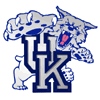 | 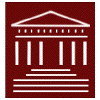 |
![]()
[Link to All-Time Series Results]
The series between Kentucky and Transylvania [the official record stands tied at 7-7: 5-6 as Kentucky University; 2-1 as Transylvania] is one that is oftentimes overlooked but is the oldest and most embittered rivalry the school has ever had. Transylvania is an ancient rival dating back to times prior to the creation of the sport of basketball itself.
The institutions share a common origin, in that at one time they were both part of the same school. Transylvania was the first public school established in Kentucky in 1780. By 1865, however, the school was in financial distress and agreed to merge with a denominational school (Bacon College at the time based in Harrodsburg) to form Kentucky University. Near the same time, the 1862 Morrill Act allowed for establishment of an agriculture and mechanical arts (A&M) school. By the time Kentucky University was formed, a college for A&M was also included in the plan, and was placed in what is today Woodland Park. This arrangement did not last, however, and A&M was spun off in 1878 as an independent state-run school. Four years later A&M took advantage of their land-grant status and moved to the South side of Lexington, taking over the City Park and fairground area, to eventually become what is today known as the University of Kentucky. (see map)
Given the proximity, close ties and shared heritage, there was always a natural connection and competition between the two schools. Football came first and a fierce rivalry was established. Once the sport of basketball took root in the early 1900s, it too was quickly added to the existing football, baseball and even debating rivalries. The relationship between the school's basketball teams was strained from the start and at times became outright hostile. Despite the on-court battles taking place over a time period less than ten years, the depth of distrust between the two at times threatened their ability to play athletics at all. This eventually led to an athletic schism between the schools, resulting in a discontinuation of competition in both basketball and football which has lasted for over 100 years.
![]()
Game by Game Review
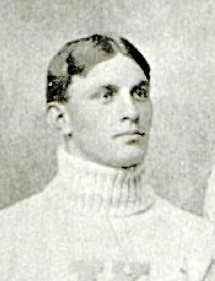 |
(Photo Credit 2) |
Transylvania at the time went by the name of Kentucky University (K.U.). They had begun playing the sport of basketball the previous year (1902), which included a two-game road trip to the North, one of which came against the University of Cincinnati (*). It was perhaps this additional experience which gave K.U. an advantage as they ran the State College men off the floor, 42-2. (The following evening the K.U. ladies played their first game, a 18-10 loss to the State College women.)
There was bad blood from the very beginning between the colleges, which at the time considered themselves sister schools. [Even the women got into the action. After the initial women's game in 1902 students of State College painted the score of the game on the outside walls of the KU art building. At the time State's school colors were Red and White. The KU curators vowed to seek to "punish the State College students if they can be found." (Article from Maysville KY Evening Bulletin, February 24, 1903). A game in 1904 was cancelled when the ladies from K.U. and State College couldn't agree whether it was proper to wear bloomers in the presence of male officials. In 1910 the two teams couldn't agree on the gymnasium to use. When no agreement could be reached, each team declared their opponent to be in forfeit.] According to the Lexington Leader the score of the first game was 10-2 and nearing halftime when a "squabble delayed the game for quite a time."
Neither the scoring leaders nor boxscore were provided in the local Lexington newspapers, however it may not be surprising that K.U. out-classed State College. Featured for the K.U. Crimson were the Yancey brothers, Hogan and Worth, along with Isaac Howard Guyn.
Howard Guyn was the oldest of the famed Guyn brothers, who in the early part of the century were considered to be the top athletes in the city of Lexington. They would be mainstays with the Lexington YMCA for years to come, and would routinely antagonize State teams who faced them during that era. At the time Howard's brother Joel White, played football and basketball for State College so the two brothers faced each other on the court.
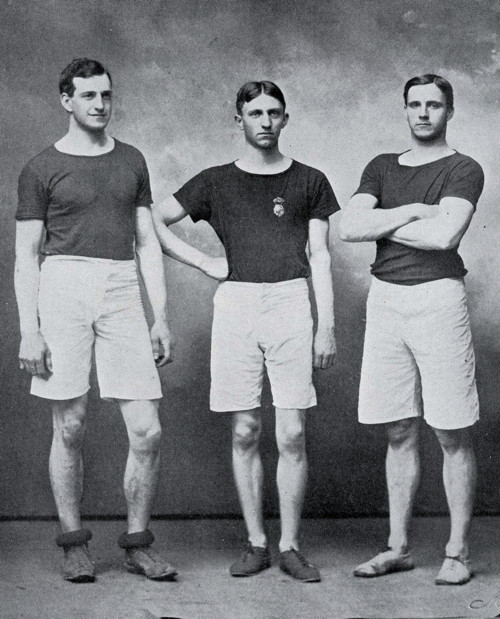 |
The Yancey brothers were all-around athletes. Their late father, George Worth Yancey had graduated from Kentucky University and become a minister. Worth was two years older than Hogan and while originally from Kentucky, they grew up in the Leesburg Va. area. Hogan had attended South Carolina in Columbia for one year before transferring to K.U. to finish his studies. In addition to starting, he served as manager of the team.
The game between the schools originally was intended to be the first of three contests. However, State College cancelled the remaining two games, likely due to the lop-sided result of the first contest. Kentucky University, by virtue of winning two games in a three-game series against Georgetown College declared themselves to be the State Champions for that year.
Noted The Transylvanian monthly:
| The supremacy of K.U.'s basket ball team over State College was a more decisive one. Kentucky University won the first game by the score of 42 to 2. When the second game was to have been played, the team from State College failed to show up. About a week later another game was arranged but again State College decided discretion was the better part of valor, and so did not put in an appearance.
The failure to keep appointments has become a habit at State College. First, it was confined to the young men; now the young ladies have caught it. The were to play their second game with the young ladies of Kentucky University last (Saturday?). But when the time for the game drew near, they cancelled the game. Their reason, or this was that K.U. did not wish to play the length of halves that State College desired. State College desired the game to be forty minutes duration and divided into quarters of ten minutes with an interval of rest between each quarter. K.U. claimed this was too long a time to play in hot weather, and would prove rather exhausting for the young ladies. . . We are sorry that our sister college thought it necessary to cancel this game. There is a need for a healthy rivalry along athletic lines between the young ladies of these institutions. It will be an incentive for them to use the gymnasium more, and anything that will produce this result should be encouraged. It is an open question, however, whether these contests should be open to the public. ("Athletics" The Transylvanian April 1903) |
[Boxscore] - 1903
*Sidenote: The fact that Transylvania at the time called themselves Kentucky University is the source of much confusion among opponents which continues to this day. Some of these schools mistakenly list the games as being played against the University of Kentucky (UK). For example the University of Cincinnati's media guide lists the 1902 game against K.U. as being against the University of Kentucky, despite the fact that UK hadn't even begun playing organized basketball at the time. A game in 1908 between Ohio State and Kentucky University (Transylvania) likewise is mistakenly listed as being against the University of Kentucky in Ohio State's media guide. This discrepancy led to confusion among officials and national media members when UK and OSU faced each other during the 2010-11 N.C.A.A. tournament. The error has since been corrected by Ohio State.
| |||||||||||||||
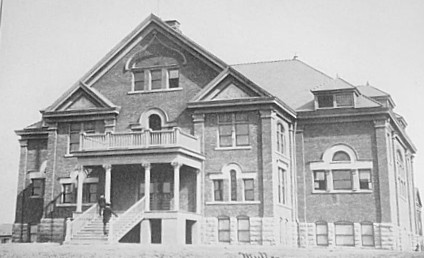 |
Kentucky University joined the group later in January of 1904, but their submission was hung up by an amendment which read "No coach or instructor in athletics or any one who has played on a professional team, or any one who has received compensation of any character for any kind of athletic services can be eligible to play on any college athletic team."
K.U. felt that this provision was aimed directly at one of their athletes, Hogan Yancey, who (along with his brother Worth) was well known to have played baseball professionally during the summer months. Only after the K.U. Athletic Council agreed to the amendment did K.U. join the association.
The two schools met twice during the 1904 basketball season. For K.U., Howard Guyn not only played but served as the manager of the team. Hogan Yancey was named the captain (but did not play due to the newly accepted K.I.A.A. provision). State College's first basketball manager was Leander Andrus. Claire St. John was K.S.C.'s captain. There were no coaches at the time at either school for the sport.
The first game that season occurred due to a fluke as Kentucky University initially was scheduled to face Georgetown College in Lexington. Site of the scheduled game was Kentucky University's gymnasium which had been built in 1894. However the two teams could not agree on a referee and the Georgetown boys returned home. (As it turned out, it may not have been surprising that Georgetown was reluctant to play as their star player, William Jones, had two days earlier fallen from a train which resulted in his arm being put in a sling. Additionally, another player Sutton had reportedly burned his shoulder on a radiator during practice and was also unlikely to be available to play.)
Luckily, the State College team was present that night and agreed to face the K.U. squad. The Crimson won the game 12-5. No boxscore was provided in the Lexington papers, although likely leading the victors was a newcomer by the name of J. Franklin Wallace who played center and was considered the star of the team.
[Boxscore] - 1904
The second game occurred near the end of the season in a game again held in Kentucky University's gymnasium and the home team came away with a 14-12 victory. The Lexington Leader declared that "the teams were evenly matched and the game was clean."
K.S.C. had been winless the entire season, although they would go on to end the season with a victory over the University of Cincinnati. Meanwhile Kentucky University, despite an earlier loss to Georgetown College, had won enough key games to lay claim to the state championship. With the victory over State College, they felt their credentials were sufficient to lay claim to the title yet again.
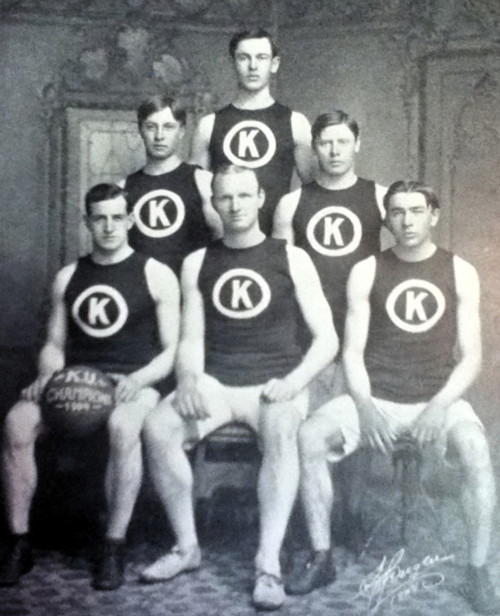 |
Hogan Yancey (with ball) did not play against State College (Photo Credit 1) |
[Boxscore] - 1904
There was supposed to be a third game scheduled on March 11 of that season, however it was cancelled due to a conflict over the eligibility of transfers. At issue was the interpretation of the K.I.A.A.'s newly implemented 'one-year rule' whereby transfers from other colleges were required to sit out a year. Each side had a transfer, Claire St. John had transferred to State from Brooklyn Polytechnic Institute while K.U.'s star J. Franklin Wallace had transferred from Marietta (OH) College. Wallace was born in 1875 and thus by 1904 was approximately 29 years old, so he was a literal man amongst boys.
During the previous game neither St. John nor Wallace participated, however for the third game Kentucky University argued that the transfer rule was intended only for transfers within the K.I.A.A., and not meant to force transfers from other schools to sit out of competition. The Faculty Athletic Committee at State College disagreed with this interpretation, and refused to allow the game to proceed unless the two players sat out. This was unacceptable to K.U. and thus the game was cancelled.
|
Sidenote:
A major source of information on happenings at Kentucky University was the monthly student-run publication called The Transylvanian. This publication was largely literary and academic-oriented but it did often provide general updates of athletics at the school and at times provided literary works which combined the two topics, as evidenced below: The first example is an article written in the January 1910 edition by Transylvania student Ms. Lulu Snyder who uses the (in)famous K.U.-State College football game from 1903 (a game which K.U. won 17-0) as the backdrop for the story of a school-age love match. The title is "An Unrecorded Score of 1903".
(Photo Credit 1) The second example is a 1904 article written anonymously entitled "Battle of K.U. Run" which describes a mythical near-battle between men of K.U. and State College through the streets of Lexington, complete with informative annotations. Not only does the article presage a near-riot downtown between fans of the schools in 1911, remarkably, the note underneath the title mentions "Manuscript Unearthed in the Year 2010 - Annotated by One Who Knows", as if it's intended to be discovered and read by future generations.
Both of these articles mention by name K.U. stars of the day, and both provide a vivid description of the time period and reflect the school spirit and enthusiasm for sports at the school. | ||||||||||||||||
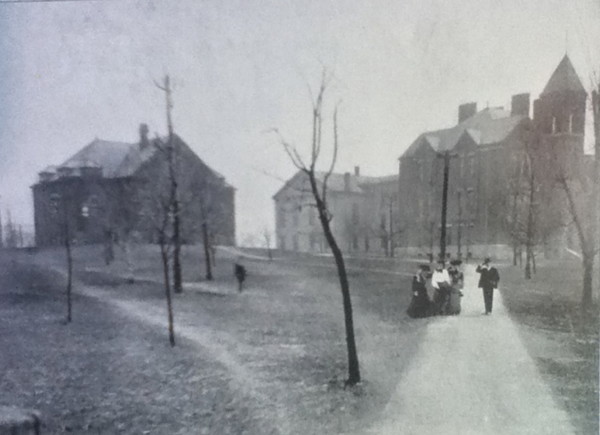 |
The rubber match between the two schools occurred February 22 at the State College gymnasium. In what was considered "one of the best of the season" the Crimson team defeated State College 33-23. Leading the way once again was J. Franklin Wallace with 18 points. Joe Coons led State College with nine points, followed by Pat Kelly with eight.
For the third year in a row, Kentucky University claimed the state championship.
[Boxscore] - 1905
Despite a promising beginning to K.U.'s basketball team and their athletic teams overall, trouble had been brewing. Some of this could be traced to the football battles with their cross-town rival. The rivalry with State College grew bigger every year as the two faced each other for the annual Thanksgiving-day game, generally marking the end of the season. For years charges of using 'ringers' increased as the game grew in importance, both financially and in terms of bragging rights.
The 1903 game proved to be the worst as charges flew between the schools leading up to the game. State College was accused of enrolling players only the week prior and actively recruiting ringers from around the country to participate. K.U. was accused of playing professionals (in particular it was noted that the Yancey brothers played baseball professionally during the summer) and had refused to join the K.I.A.A. to avoid abiding by their eligibility rules. After State College steadfastly refused to provide a list of its players prior to the game (as was customary at the time), the two sides reportedly agreed to "bring on your team and no questions will be asked."
When the game was finally held, K.U. won handily 17-0, but what was most embarrassing for State was the fact that 11 of the 13 members of the squad were found to not be regular S.C. students. Included on State's team were a number of Central University (aka Centre College) players (the Central team had disbanded earlier that season) along with at least five ringers from New York and elsewhere. Many onlookers thought at the time that State College (undefeated prior to the game) would have fared better using their own players. The scandal made news throughout the country. Both State College and K.U. were banned by the S.I.A.A. from playing any of its member schools due to the use of ringers in the Thanksgiving game.
Sidenote:
Most notable at the time was public concern over the violence of football on collegiate campuses, despite its growing national popularity. United States President Theodore "Teddy" Roosevelt among others were concerned enough to inject himself personally into the debate. The public was alarmed enough from reports of serious injuries and deaths that there was a possibility that the sport itself might be banned, unless drastic measures were taken to make the sport safer. In November 1905, Yale's Robert Forbes and fullback John "Dutch" Levine "crashed through for the touchdown" which proved the margin of victory in a 6-0 victory over Harvard, and the cap to a perfect 10-0 and national championship. But the violence of the game served to reinforce the reservations many had about the sport. After the season, representatives of sixty-two schools met in New York City and began the work of updating the rules to encourage a cleaner sport. These changes included moving the requirement for a first down from 5 to 10 yards, outlawing mass formation plays, shortening the game and adopting the forward pass. This group of schools served as the forerunner of the N.C.A.A. |
The following fall in 1904, new State College football coach F.E. Schacht played it straight, instituting a training table and giving his players plenty of rest for the big game. The preparations worked as State College used its speed to overwhelm the Crimson players 21-4.
Although the two teams had submitted their rosters early and appeared to be satisfied with the other's lists (an improvement over previous seasons), soon rumors once again started concerning the eligibility of players. In particular, the K.I.A.A., under Central representative and K.I.A.A. president Archibald Throckmorton, questioned the amateur status of some of K.U.'s athletes.
The 1905 football season saw much the same acrimony over the Thanksgiving football game. The two teams squabbled over the location of the game and questioned eligibility of players. And once again the K.I.A.A. waded into the issues, with A.H. Throckmorton, who was a notable and persistent critic of K.U., leading the charge. Throckmorton was known to contact K.U.'s opponents (including as far away as Texas A&M) to reveal his charges against the school. He also accused the K.U. faculty with breach of ethics for allowing the use of 'ringers' and players with questionable eligibility.
While Kentucky University faculty did their best to answer the charges, the continual drama wore down the support of athletics at the school by the administration. The football game between the two schools was never played; State disbanded while K.U. faced a last-minute replacement in Ohio Wesleyan. Subsequently, the faculty took steps that winter to limit athletics at the school.
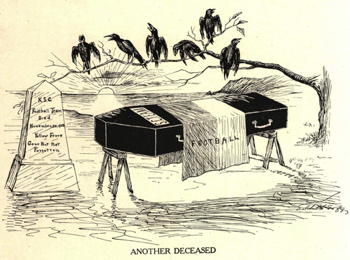 | 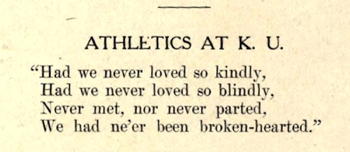 |
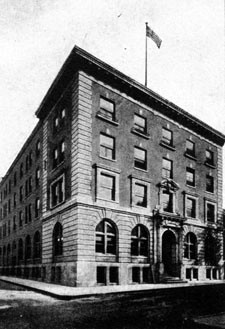 |
The K.U. basketball team played a game against Cincinnati YMCA because it had already been scheduled before the rule went into effect. The team also secretly slipped in a game against State College, unbeknownst to the faculty.
The story according to State College Team Manager Wylie B. Wendt as told to Russell Rice in Big Blue Machine: "We were scheduled to open the season against K.U.," he said, "but the athletic committees of both schools had canceled all contests after a fight at a football game (sic). The K.U. manager and I agreed to play at the YMCA and list the State opponent as the YMCA. That was crooked, of course, but that's how we got around it. State won the game, but we didn't record the score, as you can imagine why."
[No score recorded, game played at Lexington YMCA] - 1906
 |
In early March of 1906 Kentucky University's Board of Curators, citing heavy financial burdens of maintaining the football program, voted to withdraw from intercollegiate athletics altogether. (At the time K.U. had poor football facilities and played most of their games away from home, including typically the games against State College.) The vote was unanimous although it was a difficult decision and it was said that "they did not altogether desire to do so."
The prohibition was set to begin at the start of the following school year. In conjunction with ending athletics, K.U. would also resign from the K.I.A.A. that June.
The upcoming baseball season would serve as the last hurrah. Noted The Transylvanian about the precarious position athletics held in relation to the coming baseball season: "When this is read, it will be but a week until the first game of the season, that with Cornell University on March 31. Much depends on this game; in fact, a successful attendance on March 31 would make sure a financially successful season. And much depends on this season. Any indifference on the part of the student body may kill Athletics so dead that it will be useless ever to try to revive him."
The decision to withdraw from intercollegiate athletics was met with great disappointment from the K.U. student body. A mock funeral was held on the K.U. athletic field, while supporters of the fallen program hoped for "a resurrection." The Crimson yearbook showed a cartoon depicting a Tiddlywinks Tournament as their only option for entertainment during the long winter months.
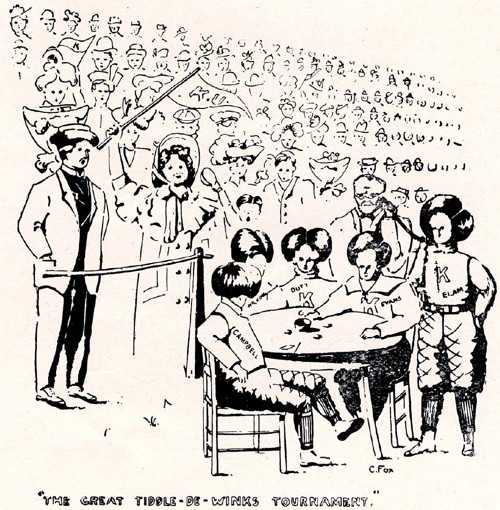 |
In October 1906, after the K.U. Board of Curators chose to uphold the athletic ban, The Transylvanian noted their understanding of the benefits of fielding teams with no hint of scandal:
| While the change will most surely be made noticeable by a paucity of college spirit and student activity, the benefits accruing from a year's 'cooling off' process may so overtop the disadvantages of the plan as to result in much permanent good, both to students and to all forms of athletics. One noticeable effect of our dormancy in the realm of athletics was the assurance given the Executive Committee that the students were in favor of a team composed of students. This attitude, though it has always existed has not been noticeably apparent heretofore. It has shown itself this early, and it will grow steadily during the year. It --the power of student of student opinion-- is the only force that can effectually bring to any college pure athletics.
This is no death-bed confession. Kentucky University will enter the field next year with a clean team and a strong one. Kentucky University has had men on her athletic teams who were not up to eligibility requirements. We admit it. We may have them again. We admit that. Yet we know that the force of student opinion developing at Kentucky University, this year, will give an impetus to the cause of pure athletics more irresistible than any rulings of faculty committees or athletic associations. ("The Athletic Situation" The Transylvanian October 1906) |
Although the ban wasn't formally repealed until March of 1907 during the K.U. Board of Curators semi-annual meeting, athletics was given new life by the Executive Committee in October 1906 to allow basketball to begin once more. In late January of 1907 a special meeting was held by the K.I.A.A. and Kentucky University was reinstated back into the fold. Two weeks later teams from K.U. and State College resumed their rivalry on the hardwood.
The game was scheduled for February 15 at the State College College gymnasium. K.U. was no longer a member of the K.I.A.A. and hadn't played a collegiate opponent, the Herald promoting the game as being for the "intercollegiate championship" even though the intention was to play a three-game series. The only common opponent played to date was the the Lexington Y.M.C.A. which had beaten State at the start of the season. Going into the game it was thought both teams were about equal, and that proved true as State College won a close game, 16-14. The Lexington Leader attributed the loss to a lack of teamwork among the Crimson players, despite "brilliant individual play."
Noted the paper "Everyone seems pleased that athletic relations have been re-established between the rivals, as the games between them have always been watched with the keenest interest."
[Boxscore] - 1907
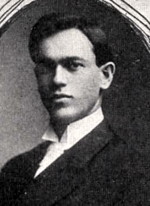 |
(Photo Credit 1) |
Also noted was the following about the K.U. gymnasium, reaffirming the uniqueness of each venue: "The gymnasium is unfortunate in having a gas jet with a handsome large globe attachment at each end, near the baskets. Four times during the game these globes were brought into play and were shattered, delaying the game considerably."
Gilbert Campbell led the Crimson with 11 of his team's 19 points, with nine of them coming from the free throw line. Shelby Shanklin was the only State College player to score, bagging two field goals and a free throw.
[Boxscore] - 1907
In 1908, State College beat Kentucky University twice by identical scores, 20-15. In the first game, held at State's gymnasium, the Cadets came back from a halftime deficit to secure the victory. The second game was held at K.U.'s gym but the result similar. The Crimson held a halftime lead only to see it lost in the second half. Maury Wilson was mentioned as starring for State while Walter Evans was the star for K.U.
[Boxscore] - 1908
[Boxscore (not complete)] - 1908
The matchup was originally intended to be a three-game series, however similar to the 1907 season, there is no record of a third game being played, for reasons unknown.
Late in the basketball season there was a notable game played in Lexington between a semi-pro team calling themselves Louisville Coliseum and a group of collegiate all-stars from local schools. The Coliseum team had already played many local college teams and had gone undefeated. The all-star team consisted of Maury Wilson of State College, Walter Evans and Haydon(**) of Kentucky University to go along with Collins and White of Georgetown College. (** No record of Haydon could be found, including on K.U.'s roster for that year, although Will Hayden had been a star of previous K.U. teams.)
The Collegiate All-Stars were no match for the experienced veterans of the Coliseum team, which won convincingly 29-12. Playing for Coliseum that day were some familiar names including K.U. alumni Howard Guyn and Hogan Yancey to go along with State College alumnus and football coach White Guyn and his brother John.
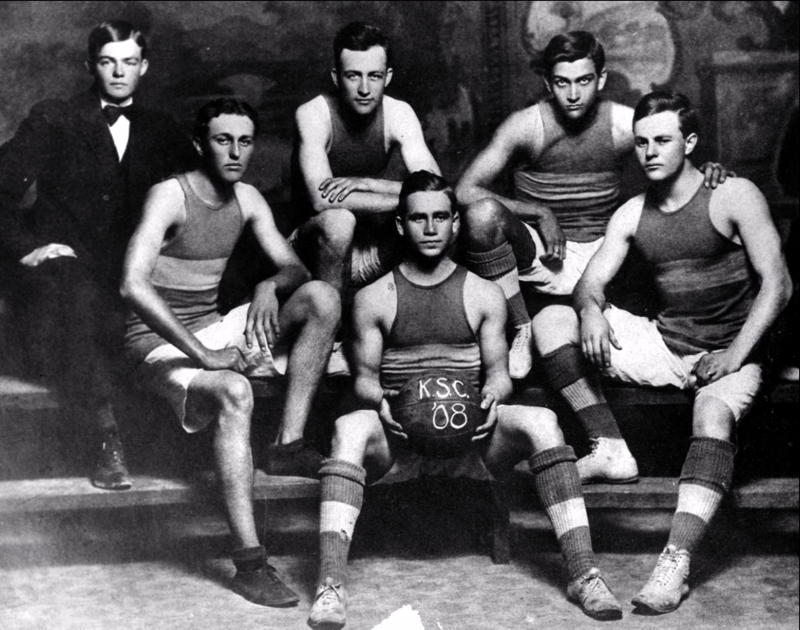 |
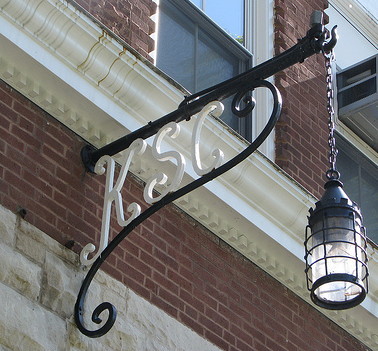 |
It was considered unfortunate that a similarly named institution, Kentucky University, was already in their midst, in the same city, and a certain source of confusion. Being a state institution, Kentucky State College believed that they were entitled to the name. K.S.C.'s Board of Trustee's appointed a special committee to meet with members of K.U. to discuss the issue.
Per a report found in the Minutes of the Board of the Trustees (December 10, 1907):
|
"The joint committee met in the City of Lexington and engaged in free and friendly discussion as to the relations of the two institutions. The Committee from the A. and M. College stated that their Board of Trustees desired to change the name of that college to "State University, Lexington, Kentucky," and contemplated taking the steps legally necessary to effect such a change; while feeling that, as the State institution they are entitled to bear the name of the State, they were embarrassed by the name of Kentucky University, already in existence and in the same city; not wishing either, to ask for legislation when might be felt to work injustice to a sister institution, they desired first to counsel with a committee from the Board of Curators of Kentucky University and if possible secure their approval of the change of name. The committee from the A. and M. College were of the opinion that, notwithstanding the similarity of names, the two institutions could work, without conflict, and expressed the hope that they might have the friendly co-operation of Kentucky University in effecting the contemplated changes." . . . The Kentucky University representatives acknowledged that "the A. and M. College is the State institution and by right is entitled to bear the name of the State. While Kentucky University is not a State institution, yet it was given the name before and State University in Kentucky was contemplated, and as "Kentucky University" it has existed half a century. The work it has done, the benefits it has conferred, the sentiments and memories that always cluster around an institution of so long and honorable a history have endeared its name to thousands of its students, alumni, and friends. It is a matter of real regret that it seems necessary to give up this name." As part of this agreement, K.U. did ask for concessions from State College, namely that 1.) State College support K.U. in its name change including backing any state legislation necessary to maintain K.U.'s current privileges, 2.) "That A. and M. College will not assume the name 'State University' until June 1, 1909" in order to give K.U. adequate time to complete its own name change and 3.) "That the A. and M. College shall pay to the Curators of Kentucky University a sum sufficient to defray all expenses occasioned to Kentucky University on account of the changes, which sum we suggest as $5,000.00." JPS Note: The above italicized quotes from Kentucky State College Board of Trustees Meeting, Dec. 10, 1907 (For complete citation see pages 1, 2 and 3.) |
This plan was set in motion as legislation was passed to allow the change, as described below:
|
The step to this effect was brought about as a result of a petition drawn up by the curators of the University requesting a change of name. the chief purpose embodied in the petition for a change of name, grew out of the fact that upon the change of name of Kentucky State College to that of State University, it was not deemed well and proper for two institutions in the State to bear similar names, both implying that of a State institution. Kentucky State College is a State institution, while Kentucky University is not primarily under the support of the State, it being more or less international. The change of name to Transylvania University will not be effective until June 12, at the close of the present college session. The new, yet old name of the institution is meeting with unanimous approval on all sides. It is considered by all to be the most appropriate name for the University, and the name "Transylvania" - "Beyond the Forest" - indicates the fact of its long existence its history covering a period of one hundred and twenty-eight years. A striking significance is shown in the meaning of the two words "Transylvania" and "Kentucky," both literally meaning "beyond the forest." ("Change of Name" Lexington Leader, April 5, 1908.) |
As noted above, K.U. officially changed their name to Transylvania on June 12, 1908. K.S.C. didn't officially become Kentucky State University until 1909. (later in 1916 they would rename themselves again to the University of Kentucky) and they did pay Transylvania $5,000 for the trouble, in installments of $500 each.
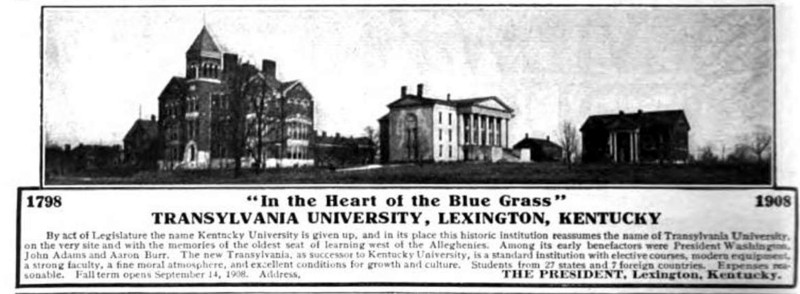 |
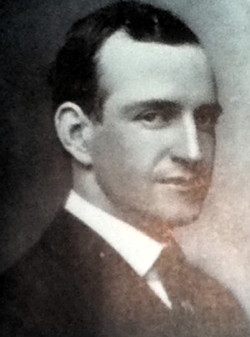 |
(Photo Credit 1) |
Yancey was a man about town. In addition to his duties with the sports teams, he also managed to get his law degree from Transylvania. At one point he even found time to pose for the Confederate General John Hunt Morgan monument which sat in downtown Lexington for over a century (before being relocated to Lexington Cemetery in 2017/2018).
Unfortunately for local fans, the ill feelings lingered through the years. More times than not, games were not played between the two schools. Part of this might be attributed to disagreement over the eligibility of players, given that standards were different between the Southern Intercollegiate Athletic Association (S.I.A.A., which State was a member of and Transylvania would join in 1914) and the K.I.A.A. (which both were members of, except for the times they weren't, such as when Transylvania abolished sports in the Spring of 1906 and later withdrew from the association that summer).
To add fuel to the fire, an iron arch with the words "Kentucky University" which hung over an entrance-way from Broadway to the Transylvania campus was sawed off and stolen one night in 1909. The theft, done presumably by State students opposed to their sister school's use of the out-of-date name, upset Transylvania students and alumni and did nothing to improve relations between the two student bodies.
In the end, two full winters passed by before Kentucky State University (as they now were called) and Transylvania saw fit to face each other on the basketball court. This renewal in athletic relations may well have been paved by a decision made during the 1910 annual meeting of the Southern Intercollegiate Athletic Association held in December in Birmingham AL. During the meeting, Kentucky professor A.M. Miller secured a rule "permitting the colleges in that association [the S.I.A.A.] to play other colleges in other associations provided the latter meet with the approval of the Executive Committee of the S.I.A.A." This ruling allowed State to remain a member of the K.I.A.A. and face local teams, while at the same time preserving its status and securing relations with fellow S.I.A.A. members, including a planned date against the University of Tennessee for a 1911 Thanksgiving game. (Above quote from Lexington Leader, "State Will Play Kentucky Teams," December 12, 1910.)
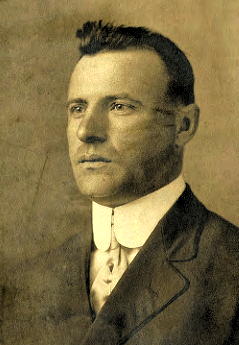 |
In response to Yancey's departure, Transylvania hired John Levine, a graduate of Yale and a student of the Yale Eastern football philosophy as outlined by Walter Camp. Levine came to Transylvania highly recommended after successful coaching stints at Davidson and Auburn. He quickly brought new life into the athletic programs at the school. (JPS Note: Levine was a ringer for Yale who played a key role in the 1905 National Championship game vs. Harvard, as noted earlier.)
Kentucky also had entered the realm of retaining a full-time coach. Edwin R. Sweetland was hired in the spring of 1909 and was extremely successful, but resigned in December 1910 due to health concerns, just as practice was to begin for the basketball squad. Harold J. Iddings was hired as a last-minute replacement.
After a three-year hiatus from playing each other on the hardwood, three games were played between Kentucky and Transylvania during the 1911 season, although they weren't all scheduled ahead of time. The first game was held in Kentucky's Buell Armory early in the season.
JPS Note: The Armory was an annex to Barker Hall, on the opposite flank of the original gymnasium. By 1910, increased demand for the gymnasium threatened the existence of organized basketball at the school. For a short time, the men's basketball team was abolished by the faculty to make room for other activities. This decision was quickly reversed after a compromise was worked out whereby maintenance staff at the University set down a wooden floor in the Armory for use by the basketball squad.
The Kentucky and Transylvania women actually played during the 1910 season. The first game, played in the Transylvania gymnasium was won by the home team 21-13. The return game, however, was not played. When the Transylvania girls arrived on State's campus, they refused to play in Buell Armory, thinking the game would be held in the old gymnasium in Barker Hall. The Kentucky women, for their part, noted that the contract (which was signed December 12, 1909) made no note of the exact location of the game, and thus Transylvania had no grounds to refuse to play. Each side claimed they deserved credit for the forfeit of the other side. The game was never rescheduled.
Transylvania won 23-18, in a game which the Leader described as "interesting." The game was close throughout until the final minutes "when the Crimson team forged to the head and secured enough lead to clinch the game." Leading the Crimson five in scoring was George Tinsley with eight points, followed by Kelly Jennings Francis with six. Kentucky center W.C. Harrison was high man for the Wildcats (a recently adopted nickname) with six points.
[Boxscore] - 1911
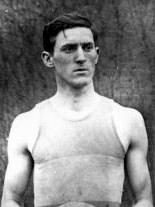 |
(Photo Credit 2) |
Wrote Clyde Davis of The Lexington Herald: "During the game there was more yelling to the square inch than Transylvania ever before heard in the gymnasium. State students were banked on the east side of the gallery and the Crimson cohorts swarmed four deep on the west side and both ends. Both the crowd and the game were record breakers."
Kentucky won this game 22-19, in what Kentucky's student newspaper The Idea described as "the fastest game of [the] season." Kentucky trailed 14-10 at halftime but came back in the final minutes to nose out their old rival. Leading the way for the Wildcats was center W.C. Harrison with 10 points. Noted The Idea: "Harrison played the best game of his career against [Kelly Jennings] Frances (sic), holding his man to no field goals, making five himself and outjumping the Transylvania captain nearly every time." Harry Maiden led Transylvania with 13 points, largely on 9 of 12 shooting from the free throw line.
[Boxscore] - 1911
With the season series tied at 1-1, a third and deciding game was held the following week at Kentucky's Buell Armory. Five hundred fifty spectators crammed into the small gym. Noted The Leader: "In addition to being one of the hardest and cleanest games of the season it was also one of the noisiest as whistles, bells and horns, added to the college yells made a noise that was deafening and sometimes players would hold their hands to their ears to keep out the din."
Transylvania led by two points at halftime and was ahead with 24-22 with four minutes remaining before State went on a run, scoring three field goals and two foul shots to win the game 30-24. Included in this run was a thirty-foot running shot by W.C. Harrison and a one-handed over the shoulder shot by Frank Marx.
Kentucky used a balanced attack with Frank Marx, Derrill Hart and W.C. Harrison providing most of the scoring punch. Transylvania was led by Harry Maiden who scored 17 of his team's 25 points.
[Boxscore] - 1911
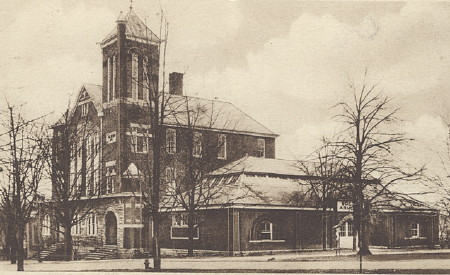 |
This brief revival of the series in 1911 would prove fruitless as this was the last time the two schools met each other competitively on the basketball court.
In the Fall of that season the two teams would meet on the gridiron and Transylvania shocked the Wildcats 5-12. That evening after the game, Transylvania students revived their "night shirt" parade tradition and flooded downtown Lexington celebrating the victory.
Noted the State college newspaper:
| "Of course, it was natural for the winning team to celebrate, and it is perfectly right that they should. In accordance with the general rule, both crowds were in town in full force. The victors appeared in night shirts and were armed with clubs. They made their entry on Main street to the beat of a drum, marching under the Stars and Stripes which was borne by a worthy alumnus of which they may well be proud. (He gained his fame by his entry into the up-to-date politics at the recent Democratic primary.)" ("A Gridiron Aftermath" The Idea, November 23, 1911) |
Unfortunately when they encountered a group of State supporters, they "attempted to beat their way through the mass with clubs" according to The Idea. A riot was imminent and was narrowly averted only after the State University President, Henry S. Barker, reportedly went into the crowd and allowed the parade to proceed.
The football victory was a moment in the sun for Transylvania, but marked the end of major athletic relations between the schools. Gloated The Transylvanian:
| As we loll in our 'easy chair' and gaze contentedly at the calendar which hangs near by on the wall, we can hardly collect our wits to write, for it is the night of November 18, a date long to be remembered in the foot-ball annals of Kentucky. With 'dope,' luck and the betting all against us, Transylvania proved today that she could come back and answered that eight-year old question, "Can Kentucky State University be defeated?" If you don't believe me, just look at that 12 to 5 score! The game is won; those night shirts which have been in peaceful repose for eight long years, have at last had their parade, in spite of some southside hoodlums; and in the language of the little boy, "It's all over but the shoutin'."
("Athletics" The Transylvanian, December 1911) |
![]()
End of an Era
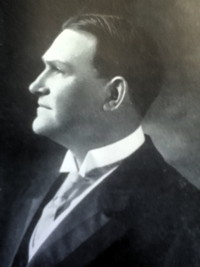 |
(Photo Credit 1) |
Unfortunately for the basketball teams, team managers of the respective schools had already agreed on dates to meet three times in 1912, however reportedly no contracts had been signed. Nevertheless, the cancellation of these games on such short notice left both schools scrambling to fill holes in their schedule.
As the basketball season got underway, apparently there was some small chance that the Transylvania faculty at a meeting in late January would reconsider and relations could be salvaged. From an article published January 22, 1912:
| While the question as to whether or not the three basketball games that were scheduled between the two institutions shall be played is ostensibly the main question for discussion, the meeting in reality very largely influences the general athletic relations of the two schools in the future as the unexpected suspension of the contracts by Transylvania was not received favorably by the adherents of State University and may lead to an absolute stoppage of all games and athletic relations between the universities.
The friends of both institutions are hoping that the Transylvania faculty will not do anything to make the broach between the schools any wider but that they will direct the playing of the basketball games and the reestablishment of general athletic relations on as friendly a basis as possible under existing conditions. The formal "burying the hatchet" meeting which eight hundred State students recently held and openly declared themselves in favor of the re-establishment of good will and friendly relations between all schools is generally considered as an expression that such relations are sincerely desired by them but it is also stated that in case Transylvania still declines to play the basketball games according to the contracts it is practically certain that all other forms of athletics will be broken off by State University. ("State and T.U. Athletic Matters" Lexington Leader, January 22, 1912) |
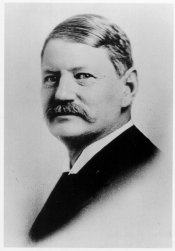 |
JPS Note: The article curiously also made mention that as part of the negotiations toward renewing relations, that "State University accepts with absolute confidence, the statement that the games heretofore scheduled between the two schools were merely tentative on the part of Transylvania and could not ripen into a contract without the approval of the faculty of Transylvania, which had not been obtained." This is noteworthy because it appears that the three-game basketball 'contract' which the managers had agreed to just prior to the Transylvania faculty's decision was a major issue and point of contention between the two sides. It also clarifies that the Kentucky side considered the agreement to be enforceable, meaning that Transylvania's decision to withdraw from athletic relations violated this agreement, whereas Transylvania didn't consider it to be binding.
On February 8, the State College student newspaper The Idea expressed hope that rumors that two, and possibly three games would be played were true and noted "There is no doubt but that these games will be the biggest drawing card in the whole season and will be a fight to the finish." Furthermore they stated that "The students of this institution have pledged themselves to treat the T.U. students with courtesy, or rather to leave them alone, and we must live up to our pledge." (above quotes from "T.U. Likely to Play.," The Idea February 8, 1912).
The following day it was noted in the Lexington Leader that "the coming State-Transylvania games, which now seem to be definitely decided upon" ("Transylvania," Lexington Leader February 9, 1912). Even as late as February 14 eve, two days prior to the first proposed game, Transylvania's manager C.O. Cossaboom confirmed the intention to play two, perhaps three games.
However the day the game was to be played, the Lexington Leader reported State's coach E.R. Sweetland as saying that no specific time and place for future games had been established, and that he intended to end the basketball season by March 1. With two games scheduled against Vanderbilt (games which were negotiated when State and Transylvania had been deadlocked) along with a game scheduled with Georgetown, it was felt there was little availability to schedule a series with Transylvania.
A last-gasp attempt saw the Athletic Councils of the two schools agreeing to three dates: Tuesday March 5, Friday March 8 and Tuesday March 12, with two games being played at Transylvania and one at State College. The problem being that these dates would necessarily lengthen the basketball season for both schools. It was this stipulation that likely doomed the agreement, as neither of the schools' administrators were interested in doing so.
On February 21, 1912, the State University Athletic Committee met and declared that the end of the season would coincide with the March 1 game versus Georgetown College. Several reasons were cited for this decision: "After March 1 indoor baseball practice must be begun, with the armory, the building in which basket ball practice has been carried on, as the site for indoor baseball practice; track athletics practice also must begin within a few days after March 1; the armory, the scene of basket ball practice and games, must be used for girls basket ball practice and games, boxing classes and indoor track work." ("State's Season Will be Closed on March 1" Lexington Herald February 22, 1912)
Despite the failed attempts at renewing the series, the Kentucky basketball team enjoyed an excellent 1912 season, going undefeated with a record of 9-0, including victories over Vanderbilt and Tennessee. This was the program's best record ever, and considered sufficient to proclaim themselves "Champions of the South." Transylvania also had a good year, but the lack of a head-to-head matchup with State University made it difficult to claim glory. Noted The Transylvanian late in the season:
| The Varsity team is very strong this season, as predicted. They have already defeated Georgetown College in a one-sided contest, and with some training and a little more team work it should be no trouble for this team to put in a strong claim for the championship. There can be no definite decision, however, as our Faculty has recently seen fit to abolish athletic relations with the State University and a match between these two claimants will be impossible. It is hoped that this abolition will be repealed, because "State" is always a drawing card, and then -- "we jest naturally likes to lick 'em."
("Athletics" The Transylvanian February 1912) |
The Kentucky viewpoint was much harsher towards Transylvania, and showed signs that the school was ready for bigger and better things. As noted in the 1912 review of the season by The Idea:
| Next comes the saddest tale of all. Our old friends (?) Transylvania refused to submit to a good, sound thrashing, and began doing the "baby act" and canceled or rather refused to play the games scheduled with us. They never did give any real reasons for their actions, but to an onlooker it seems that they simply didn't want to get beat, and took the only available course to prevent it. This left our schedule in a pretty bad fix, but suffice it to say we survived. |
As part of a restructuring of its athletics, Kentucky dissolved the faculty athletic committee in favor of a salaried athletic director supported by a 10-member board consisting of faculty, students and alumni. This arrangement diluted the power the faculty previously held over athletics at the school. The move also weakened relations with the K.I.A.A. at the time as it was the chairman of the faculty athletic committee whose responsibility it was to represent the University at the K.I.A.A. With the structural changes, State had no formal representative assigned to the state association.
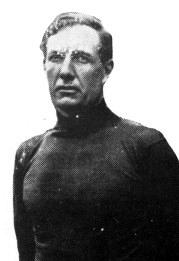 |
Newly appointed Athletic Director Edwin R. Sweetland (who returned to the school after a year recuperating from illness) noted that Kentucky had won more state titles than any other school, in support for the move away from competing against local teams. Some thought the move was preemptive in that rumors were percolating that the K.I.A.A. was preparing to enforce a one-year ban against Kentucky anyway.
As it turned out, the rumors proved accurate as the K.I.A.A. did go ahead and forbid any of its members from playing Kentucky, based on charges against Jim Park for playing summer baseball and for the football program admitting players lacking the requisite credits.
Incidentally, the morning after the K.I.A.A. decision, Transylvania students met to discuss the relationship with Kentucky State University and to debate the cessation of all intercollegiate contests with the school. While there was much that occurred leading up to this, what precipitated the meeting was the vandalism of T.U. buildings and sidewalks by State students with 'bright blue paint' after a baseball victory on May 31. According to the Lexington Leader "the sentiment expressed in this morning's meeting was that the students could act independently of the faculty and president in the matter and consequently the resolutions were introduced."
Below is the Transylvania student's resolution in its entirety:
| "Whereas, a portion of the students of Kentucky State University have on various occasions shown their inability to conduct themselves in a sportsmanlike manner in connection with athletic contests between Transylvania University and Kentucky State University and have been guilty of conduct unbecoming gentlemen and
"Whereas, Transylvania University has on several occasions suffered in various ways as the result of such conduct on the part of the said portion of Kentucky State University students, and in particular as the result of the rowdyism of some of the Kentucky State University students on the night of Nov. 18, 1911, after a defeat in football, and as the result of their vandalism on the night of May 31 after a victory in baseball, when they defaced the buildings and grounds of Transylvania; showing thereby their inability to take either victory or defeat in sportsmanlike manner, and "Whereas, the last named offense was committed after the Transylvania students, faculty and president had been assured by the Kentucky State University students, faculty and president, that such offenses would not again be committed, and "Whereas, furthermore we consider as insulting the presumption that a money payment alone is sufficient reparation for the damage inflicted, therefore be it "Resolved, that we, the students of Transylvania University in mass meeting assembled, hereby declare ourselves unwilling to enter into any collegiate contests in which the Kentucky State University participates until we shall be thoroughly convinced that the spirit of the whole student body of Kentucky State University will be such as to render impossible any repetition of the kind of conduct herein mentioned. And furthermore be it "Resolved that a copy of these resolutions be sent to the President of Kentucky State University, to the President of Transylvania University, and to the Lexington and Louisvile papers." ("Transylvania Severs Relations with State" Lexington Herald June 6, 1912) |
While the K.I.A.A.'s decision the day before had already severed sanctioned athletic ties between the two schools, this decision by the Transylvania students extended the ban to other areas, such as oratory and debating contests, which were also popular events at the time.
The K.I.A.A.'s decision affected not only a game scheduled November 9th against Transylvania but more importantly impacted a planned Thanksgiving-day football game scheduled with Central University. Central and State had signed to play under S.I.A.A. rules, given that both were members of that association, however the K.I.A.A. ban undermined this arrangement. In the end, Transylvania and Central ended up facing each other over Thanksgiving while Kentucky was left in the cold, scrambling to schedule the Cincinnati YMCA, which proved to be a financial disaster for the school.
To make matters worse, Kentucky's coach E.R. Sweetland found himself entangled in the fall-out from an arson scandal attributed to a football assistant coach, Richard Webb, along with UK student Thomas Butler. Sweetland later resigned his position in early 1913 due to the scandal.
Meanwhile, in late November 1912 the S.I.A.A. suspended Kentucky for the same charges the K.I.A.A. held against them along with an additional charge against William "Red Doc" Rodes for appearing in a football game after his four years of eligibility was already completed. After a hearing in December 1912, the brief suspension was lifted when the committee determined according to the Lexington Herald "the offenses committed by Kentucky were due to negligence on the part of the Athletic Committee of that institution and not to any intentional violation of the rules of intercollegiate association regulations as set forth by the Association." ("State University's Suspension Raised By Southern Board" Lexington Herald, December 13, 1912)
In the end, the K.I.A.A. members who forwarded their charges to the S.I.A.A. likely further soured State's relations with the local schools. Relations were broken off for a number of years. Even Transylvania joining the S.I.A.A. in 1914 didn't change the situation, despite the Lexington Leader confidently claiming at the time that the "resumption of athletic contests between that University [Transylvania] and State is now assured." ("Transylvania Joins S.I.A.A." Lexington Leader December 12, 1914)
Only in late 1915 when the University of Louisville wanted to join the K.I.A.A. but retain its burgeoning and lucrative series with State University, was a compromise reached. As part of the deal, Kentucky agreed to repay old fees which the K.I.A.A. claimed it was owed at the time Kentucky left the association in 1912. In return, K.I.A.A. members were once again allowed to renew relations with the State University.
Eventually every member of the K.I.A.A. did indeed renew athletic relations with the University of Kentucky; every member, that is, except their ancient rival and "sister school" Transylvania.
![]()
Postscript
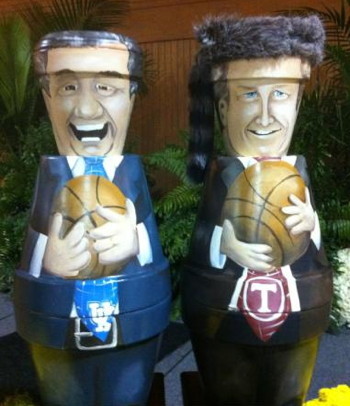 |
Since that time Kentucky had gone on to become the all-time winningest basketball program in college basketball. Meanwhile Transylvania, although having a successful and proud program (with notable coaches being former UK player C.M. Newton, Lee Rose and later Don Lane) found itself in Division III. Transylvania stopped playing football competitively in 1941.
Two days before the game occurred, the occasion was marked by a joint team banquet at the Keeneland Entertainment Center. Joked UK coach John Calipari about the fact that the two schools hadn't met in over 100 years and acknowledging that his team was a heavy favorite: "And if they beat us, it'll be another 100 years."
Tickets were available to the public along with a silent auction and proceeds went to support Transylvania athletics. Wrote Transylvania coach Brian Lane "We really appreciate Cal and his staff working with us on such a unique event. . . Their willingness to take the time to help us raise money for our athletic department prior to such a historic game speaks volumes about the relationship that the two schools foster. It was a big time event that our players, alums and supporters thoroughly enjoyed. Thanks to Cal for making it happen." ("Kentucky Basketball Coach Calipari shows his support for Transylvania University" by John Clay, Lexington Herald-Leader October 31, 2011)
The game itself made fans of both schools proud. Transylvania came out poised and played well, keeping Kentucky from pushing the pace and spreading out floor to find open shooters on the perimeter, rather than forcing the action near the basket against the much taller Wildcats. Brandon Rash hit a 3-point shot to give Transylvania an 11-4 lead, however late in the first half Kentucky began to pull away.
The final score was 97-53. The Wildcats were led by Terrence Jones with 22 points while freshman Michael Kidd-Gilchrist added 19 points. For the Transylvania Pioneers, Tate Cox led the team with 15 points followed by Barrett Meyer with 13 and Ethan Spurlin with 12.
Because the game was an exhibition, the result does not count in the official records, meaning the all-time series record between the schools remains tied at 7-7.
![]()
- Wednesday, November 2 2011 -
![]()
Transylvania - 53 (Head Coach: Brian Lane)
| Player | Min | FG | FGA | 3pt FG | 3pt FGA | FT | FTA | Off Reb | Def Reb | Tot Reb | PF | Ast | St | BS | TO | Pts |
|---|---|---|---|---|---|---|---|---|---|---|---|---|---|---|---|---|
| Ethan Spurlin | 26 | 4 | 9 | 1 | 1 | 3 | 5 | 2 | 4 | 6 | 4 | 1 | 1 | 0 | 2 | 12 |
| Brandon Rash | 20 | 3 | 8 | 2 | 5 | 0 | 0 | 0 | 1 | 1 | 5 | 2 | 0 | 1 | 1 | 8 |
| Tate Cox | 33 | 5 | 14 | 5 | 12 | 0 | 0 | 2 | 1 | 3 | 2 | 1 | 0 | 0 | 3 | 15 |
| Barrett Meyer | 28 | 5 | 13 | 3 | 9 | 0 | 0 | 0 | 4 | 4 | 1 | 3 | 0 | 0 | 0 | 13 |
| Chris Owens | 32 | 0 | 6 | 0 | 3 | 0 | 0 | 1 | 0 | 1 | 3 | 1 | 2 | 0 | 2 | 0 |
| Tommy Sirkin | 3 | 0 | 1 | 0 | 1 | 0 | 0 | 0 | 0 | 0 | 2 | 0 | 0 | 0 | 2 | 0 |
| Trey Beuttel | 1 | 0 | 0 | 0 | 0 | 0 | 0 | 0 | 1 | 1 | 0 | 0 | 0 | 0 | 1 | 0 |
| Jordan Gilbert | 1 | 1 | 3 | 1 | 2 | 0 | 0 | 0 | 0 | 0 | 0 | 0 | 0 | 0 | 0 | 3 |
| Michael Stone | 4 | 0 | 0 | 0 | 0 | 0 | 0 | 0 | 0 | 0 | 0 | 0 | 0 | 0 | 1 | 0 |
| Nick Fudge | 4 | 0 | 0 | 0 | 0 | 0 | 0 | 0 | 0 | 0 | 1 | 1 | 0 | 0 | 0 | 0 |
| Taylor Botkin | 17 | 0 | 0 | 0 | 0 | 0 | 0 | 1 | 0 | 1 | 0 | 1 | 0 | 0 | 2 | 0 |
| Matthew Clevenger | 7 | 0 | 1 | 0 | 1 | 0 | 0 | 0 | 0 | 0 | 0 | 2 | 0 | 0 | 1 | 0 |
| Ashley Hatfield | 7 | 0 | 3 | 0 | 3 | 0 | 0 | 0 | 0 | 0 | 0 | 0 | 0 | 0 | 1 | 0 |
| Gavin Dunagan | 14 | 1 | 3 | 0 | 1 | 0 | 0 | 1 | 4 | 5 | 1 | 1 | 0 | 0 | 1 | 2 |
| Jimi Starks | 1 | 0 | 0 | 0 | 0 | 0 | 0 | 0 | 0 | 0 | 0 | 0 | 0 | 0 | 0 | 0 |
| Mike Satterwhite | 1 | 0 | 0 | 0 | 0 | 0 | 0 | 1 | 0 | 1 | 0 | 0 | 0 | 0 | 0 | 0 |
| Leavitt Morrison | 1 | 0 | 0 | 0 | 0 | 0 | 0 | 0 | 0 | 0 | 0 | 0 | 0 | 0 | 0 | 0 |
| Team | 3 | 1 | 4 | 1 | ||||||||||||
| Totals | 200 | 19 | 61 | 12 | 38 | 3 | 5 | 11 | 16 | 27 | 19 | 13 | 3 | 1 | 18 | 53 |
Kentucky - 97 (Head Coach: John Calipari)
| Player | Min | FG | FGA | 3pt FG | 3pt FGA | FT | FTA | Off Reb | Def Reb | Tot Reb | PF | Ast | St | BS | TO | Pts |
|---|---|---|---|---|---|---|---|---|---|---|---|---|---|---|---|---|
| Terrence Jones | 26 | 9 | 13 | 0 | 0 | 4 | 7 | 3 | 9 | 12 | 1 | 2 | 0 | 0 | 1 | 22 |
| Anthony Davis | 29 | 2 | 7 | 0 | 1 | 2 | 3 | 3 | 5 | 8 | 2 | 0 | 0 | 8 | 2 | 6 |
| Darius Miller | 27 | 4 | 7 | 2 | 5 | 0 | 0 | 2 | 3 | 5 | 2 | 4 | 1 | 1 | 0 | 10 |
| Doron Lamb | 28 | 8 | 11 | 3 | 6 | 0 | 1 | 0 | 1 | 1 | 0 | 1 | 2 | 0 | 0 | 19 |
| Marquis Teague | 31 | 5 | 11 | 1 | 5 | 3 | 5 | 0 | 1 | 1 | 3 | 9 | 2 | 0 | 2 | 14 |
| Jarrod Polson | 3 | 0 | 1 | 0 | 1 | 0 | 0 | 0 | 0 | 0 | 0 | 0 | 0 | 0 | 0 | 0 |
| Sam Malone | 1 | 0 | 0 | 0 | 0 | 0 | 0 | 0 | 0 | 0 | 0 | 0 | 0 | 0 | 0 | 0 |
| Michael Kidd-Gilchrist | 25 | 9 | 12 | 1 | 2 | 0 | 0 | 0 | 7 | 7 | 2 | 5 | 0 | 1 | 2 | 19 |
| Eloy Vargas | 11 | 0 | 0 | 0 | 0 | 0 | 0 | 0 | 2 | 2 | 1 | 0 | 0 | 1 | 0 | 0 |
| Brian Long | 1 | 0 | 0 | 0 | 0 | 0 | 0 | 0 | 0 | 0 | 0 | 0 | 0 | 0 | 0 | 0 |
| Kyle Wiltjer | 18 | 2 | 4 | 0 | 0 | 3 | 4 | 4 | 3 | 7 | 1 | 1 | 1 | 0 | 1 | 7 |
| Team | 1 | 1 | 2 | |||||||||||||
| Totals | 200 | 39 | 66 | 7 | 20 | 12 | 20 | 13 | 32 | 45 | 12 | 22 | 6 | 11 | 8 | 97 |
![]()
![]()
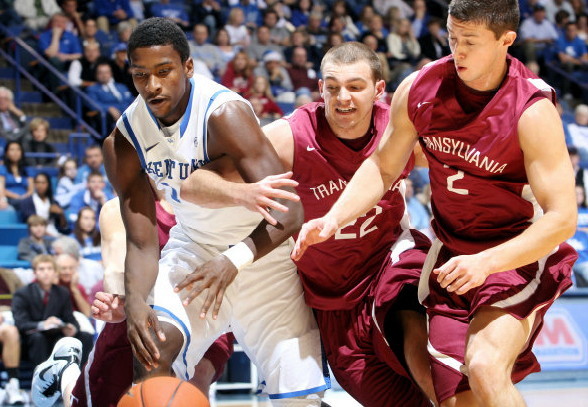 |
![]()
Please note that the following reference materials were consulted for the above. 1.) Lexington Herald 2.) Lexington Leader 3.) The Transylvanian 4.) The Crimson (Transylvania yearbook) 5.) The Idea (UK student newspaper) 6.) The Kentuckian (UK yearbook) 7.) Big Blue Machine by Russell Rice (Strode Publishers, 1978) 8.) Before Big Blue by Gregory Kent Stanley (The University Press of Kentucky, 1996) 9.) Transylvania: Tutor to the West by John D. Wright Jr. (The University Press of Kentucky, 2006) among others. Return to Kentucky Rivalries, Transylvania Series Results, statistics, teams, opponents, players, coaches, opposing coaches, games or search this site.
I would also like to thank B.J. Gooch of the Transylvania Special Collections library, Laura Hall of the UK Reference Desk, the University of Kentucky William T. Young and Special Collections library staff, the Scott family for locating articles and the Lexington Public Library staff who created and maintain the Lexington Public Library History Index.
Photo Credits: 1. Crimson (Transylvania) Yearbook; 2. Kentuckian (UK) Yearbook.
Page written by Jon Scott. Please with any corrections or additional information.
Last Updated May 8, 2012